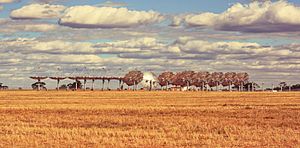Mildura Solar Concentrator Power Station facts for kids
Quick facts for kids Mildura Solar Concentrator Power Station |
|
|---|---|

The 1.5 MW demonstration facility completed in 2013
|
|
| Country | Australia |
| Location | Mildura, Victoria |
| Coordinates | 34°27′58″S 142°11′00″E / 34.46611°S 142.18333°E |
| Construction began | 2012 |
The Mildura Solar Concentrator Power Station was a big plan for a solar power plant in Australia. It was going to be built near Mildura, Victoria, in a place called Carwarp. The idea was to build a plant that could make 100 MW of electricity.
This project used a special kind of solar technology. It was called concentrated photovoltaic (CPV). This means it used mirrors to focus sunlight. The company Solar Systems first suggested the project in 2006. Later, another company, Silex Systems, took over Solar Systems in 2010.
A smaller test plant was finished in 2013. This plant could make 1.5 MW of power. The bigger 100 MW plant was supposed to start being built in 2014. It was planned to be finished by 2017. However, the plan was stopped in August 2014. This happened because of several reasons. These included low prices for electricity and a lack of support for clean energy from the Australian government. There was also uncertainty about Australia's Renewable Energy Target.
Contents
Project History
Early Plans and Delays
The idea for a large solar plant was first announced in 2006. It was meant to be a 154 MW plant. The project was expected to be ready by 2013. But there were some delays. Solar Systems, the company behind the project, faced financial problems. This happened during the global financial crisis in 2008.
Test Plant and Project End
Even with the delays, a smaller test plant was completed in 2013. This showed that the technology worked. However, the plan for the much larger plant was eventually given up in 2014.
How the Technology Worked
The CS500 Dish Design
The Mildura project used a special design called the "CS500" dish. This dish had 112 curved mirrors. These mirrors were designed to follow the sun. They moved throughout the day to always face the sun. This way, they could gather the most sunlight.
The mirrors focused the sunlight onto a special solar receiver. This receiver then turned the concentrated sunlight into electricity. The system could make electricity as long as the sun was more than 5 degrees above the horizon.
Turning Sunlight into Power
The electricity made by the receivers was direct current (DC). This DC power then went through a solar inverter. The inverter changed the DC power into alternating current (AC). AC is the type of electricity used in homes and businesses. Transformers then increased the voltage. This made the electricity ready to be sent into the local power grid.
Benefits of This Solar Technology
The CS500 dish design had several good points:
- Longer Lifespan: This type of solar dish was expected to last longer than regular solar panels. The part that converts sunlight to electricity was very small. This made it easier and cheaper to maintain.
- Special Protection: The system included a filter. This filter removed harmful UV light. UV light can reduce how well traditional solar panels work and shorten their life.
- Cooling System: The modules in the dish were also cooled. This helped them work better and last longer.
- Lower Cost: The CS500 dish was designed to cost less per watt of power produced. This was compared to traditional solar panel technology. As the technology improved, the cost was expected to go down even more.
- More Electricity: The CS500 dish could produce up to 30% more electricity. This was compared to flat solar panels that don't move. This is because the dish tracks the sun. It also operates at cooler temperatures.
Other Solar Projects
This solar technology was also used in other places. Four smaller solar power stations were built in central Australia. These projects received help from the Australian Greenhouse Office.
See also
 In Spanish: Central eléctrica de concentración solar Mildura para niños
In Spanish: Central eléctrica de concentración solar Mildura para niños
- Solar power in Australia
- Energy policy of Australia

